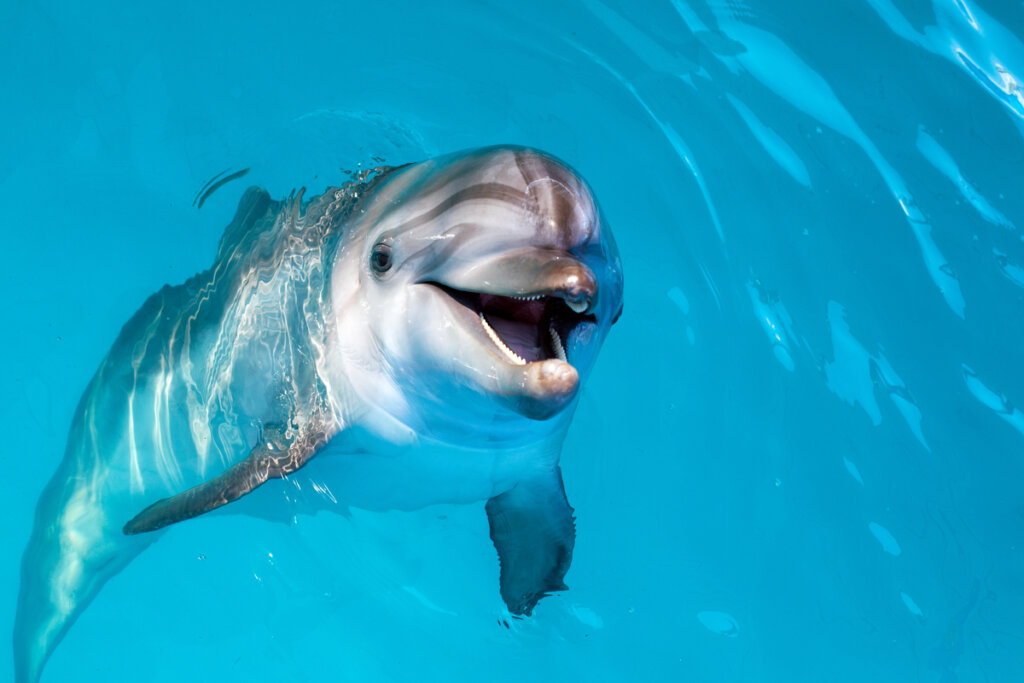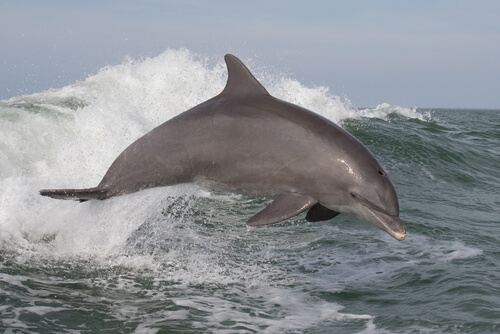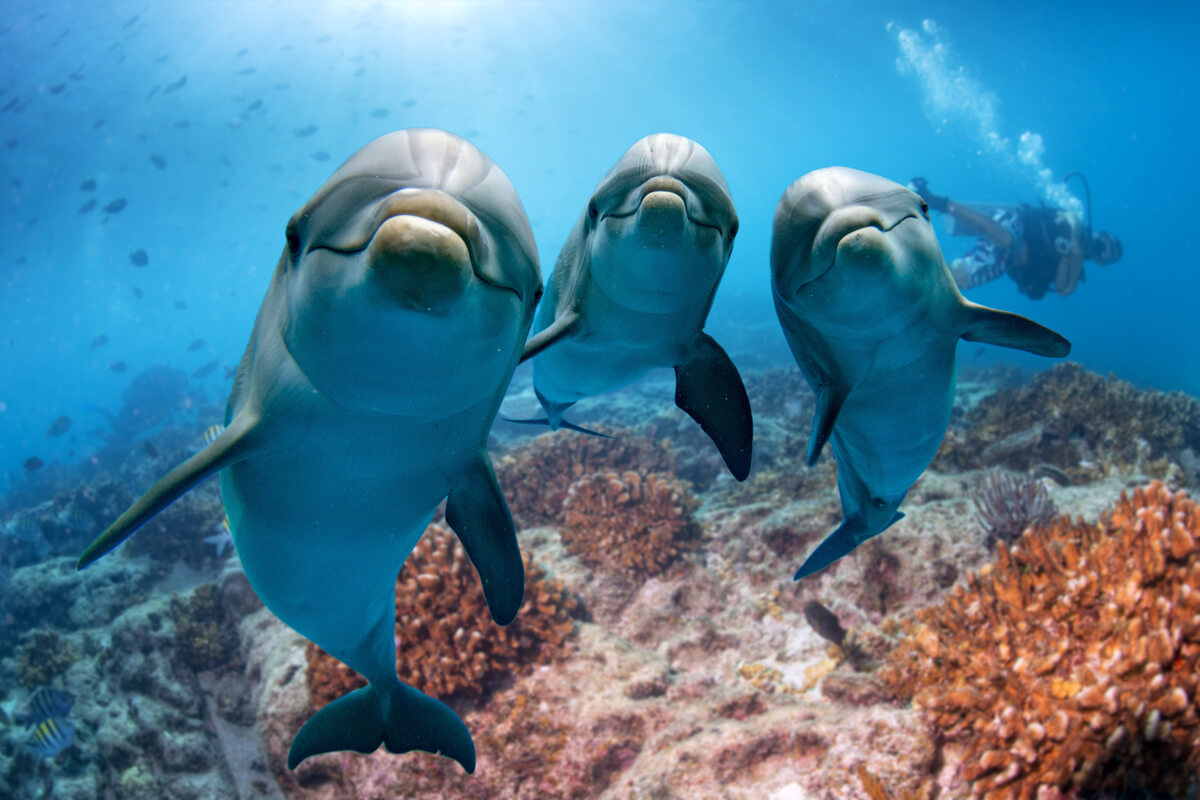Did You Know that Dolphins Name Each Other?

Dolphins are characterized by their cute appearance and gentle behavior, making them extremely popular among people. They’re also considered to be the marine mammals with the greatest cognitive capacity, so it’s common to see them learning tricks for aquarium presentations. However, did you know that some dolphins name each other?
When we’re talking about dolphins, we’re actually referring to a diverse group of several species found in the family Delphinidae. However, out of all of them, the bottlenose dolphins (Tursiops truncatus) stand out, and they have demonstrated such complex behaviors as naming each individual in their group. Read on to find out how they do it.
What does the bottlenose dolphin look like?
The physical appearance of the bottlenose dolphin is well-known to most people. Its body is semi-arched, with one dorsal fin and two pectoral fins. In addition, its tail is horizontal, which is a characteristic that differentiates it from the fish group.
This dolphin exhibits gray coloration on its back and white on its belly. This trait is an adaptive characteristic known as counter-shaded coloration. Simply put, when seen from the surface it blends in with the dark ocean floor, while when seen from the depths it blends in with the reflection of the sun.
The dolphin’s head is one of the most complex features it possesses. On its back, it has a blowhole that serves as an air intake for its respiratory system, although it’s also responsible for producing the typical sounds of this animal. Contrary to what one might think, this species doesn’t have vocal cords, but uses certain folds known as phonic lips to produce its vocalization.
As if that weren’t enough, these mammals also have a specialized “organ” known as a melon, which they use as if it were a sounding board. Thanks to it, sound is transmitted in the water and dispersed in different directions. It’s even used for echolocation.

Bottlenose dolphin communication
The great ability of dolphins to produce sounds underwater allows them to communicate with each other. For this reason, they continuously emit clicks and whistles while swimming in their environment. Although they appear to be the same, each vocalization is used in a different way.
The clicks are usually made up of small pulses (about 300 per second) that are used for echolocation. Once they go out, the echo that resonates around them is received by the melon and by their jaw, which helps them to perceive their surroundings.
Whistles, on the other hand, are a bit more complex and consist of uniform sounds that are used specifically for communication. They use them to emit messages of alarm, sexual arousal, and other emotional states. In fact, they’re able to associate certain situations with specific vocalizations, so that in captivity they can be trained to learn to name objects.
A sound associated with each specimen
The ability of dolphins to associate objects or situations with a specific whistle is very similar to what’s observed in human language. It isn’t surprising then that these mammals are also capable of associating a vocalization with each specimen. In other words, we could say that dolphins name each other.
A study published in the journal Proceedings of the National Academy of Sciences recorded the vocalizations of several bottlenose dolphins and played them back to see the effect on their behavior. Surprisingly, they found that certain sounds caused the dolphins to approach as if it were a type of call.
Thanks to this experiment, it’s possible to affirm that dolphins are capable of naming the individuals they interact with. In fact, they’re the first beings to present this ability apart from humans, which reaffirms their position as one of the smartest animals in the world.
Why do dolphins name each other?
The fact that dolphins name each other isn’t so difficult to explain, as it seems to be related to their distribution behavior. Dolphins swim constantly and don’t tend to stay in one place for long. That’s why they need a name to refer to each of their group members, as this way they can locate and keep close to each other without any problem.
In addition, mothers also use this ability to keep track of their calves. In this way, they increase the survival rate of the young and the reproductive success of the species. Although to human eyes it might not seem an incredible ability, the reality is that it has a great impact on dolphin adaptation.

This ability makes it clear that we still haven’t discovered so many impressive secrets about animals and their biological makeup. So, even though dolphins are the first non-human mammal to show they have such an ability, it’s not likely to be the only one. There’s still much to know and discover, so we can only wait for science to take its course.
All cited sources were thoroughly reviewed by our team to ensure their quality, reliability, currency, and validity. The bibliography of this article was considered reliable and of academic or scientific accuracy.
- Janik, V. M., Sayigh, L. S., & Wells, R. S. (2006). Signature whistle shape conveys identity information to bottlenose dolphins. Proceedings of the National Academy of Sciences, 103(21), 8293-8297.
- King, S. L., & Janik, V. M. (2013). Bottlenose dolphins can use learned vocal labels to address each other. Proceedings of the National Academy of Sciences, 110(32), 13216-13221.
- Ordaz, I. G. (2014). El lenguaje del delfín. Con-Ciencia Boletín Científico de la Escuela Preparatoria No. 3, 1(1).
- Alliance (2017). Delfín Nariz de Botella. Recuperado el 9 de abril de 2022, disponible en: https://www.ammpa.org/sites/default/files/files/animalfactsheets/AMMPA-DolphinFactSheet-SPANISH-PRINT.pdf
